Monday, February 22, 2010
Sea of Cortez Threatened
 Life in the Sea of Cortez is endangered by destructive new fishing methods.
Life in the Sea of Cortez is endangered by destructive new fishing methods.Ten years ago graduate students Octavio Aburto-Oropeza and Gustavo Paredes surveyed the marine life of the Sea of Cortez (also known as the Gulf of California). In 2009 they went back and were shocked at how things had declined. Sixty percent of the surveyed sites showed signs of degradation, according to Aburto-Oropeza, and many are now missing the top predators normally present in healthy, functioning ecosystems.
"Ten years later we can actually measure the effects of not putting conservation measures in place," Paredes told Explorations Magazine. "Some of us had been conducting surveys in certain sites every year, but until this year we didn't know the whole story of what was going on."
The changes have occurred because of fishing. Traditional hook-and-line fisherman have been put out of business by vastly more damaging gill net fishing and "hookah" diving. Hookah fishermen use surface-supplied air through piping that allows them to walk along the seafloor for long periods of time. The technique is typically conducted at night when fish are resting, allowing the hookah fishermen to spear or grab large numbers of vulnerable fish and invertebrates.
In the most dramatic example of fishing impacts observed on the 2009 expedition a survey of San Esteban Island in the north revealed reefs devoid of fish and instead covered by mats of cyanobacteria.
There are areas which have flourished, though. One example is Cabo Pulmo near the southern tip of the Baja peninsula. Fishing restrictions there since 1995 have ensured that Cabo Pulmo retains a mix of sea life and flourishing fish populations. Other successes include Coronado Island inside the Loreto marine park and Los Islotes inside Espiritu Santo marine park.
Using compressed air has been banned in Mexico for sports fishermen for 40 years, but since commercial fishermen weren’t named specifically they had been allowed to use compressed air to clean the reef. In May 2009 this changed: the use of hookahs have now been outlawed for any type of fishing. Illegal fishing still goes on though, and environmental organisation Sea Watch is asking people to report any that they encounter at http://seawatch.org/en/Resource-Library/359/report-illegal-fishing
Further Reading:
Scripps Institution of Oceanography
Labels: dive destination, environment, research, SCUBA diving, SCUBA News, SCUBA Travel
Wednesday, January 20, 2010
Creature of the Month: Burrowing Anemone
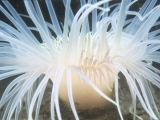 This common species - Cerianthus lloydii - is not a true anemone but a tube anemone. Instead of attaching itself to a rock it lives in a soft felt-like tube protruding above sand or mud. The anemone's tentacles are usually all that is visible. The inner set circle the mouth and are short and stiff. The long, flexible and attractive outer ones, over 100 of them, sweep prey inwards. When disturbed the whole anemone shoots back into its tube, like a tubeworm. The tentacle crown measures up to 10 cm across.
This common species - Cerianthus lloydii - is not a true anemone but a tube anemone. Instead of attaching itself to a rock it lives in a soft felt-like tube protruding above sand or mud. The anemone's tentacles are usually all that is visible. The inner set circle the mouth and are short and stiff. The long, flexible and attractive outer ones, over 100 of them, sweep prey inwards. When disturbed the whole anemone shoots back into its tube, like a tubeworm. The tentacle crown measures up to 10 cm across.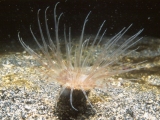 The animals live from the shallows down to 100 m. The tentacles may be white, brown, green or banded.
The animals live from the shallows down to 100 m. The tentacles may be white, brown, green or banded.You can find the burrowing anemone around the British Isles and in North West Europe to the Bay of Biscay.
Further Reading:
Great British Marine Animals, by Paul Naylor, Deltor (2003)
What do you think of this news item? Join a discussion.
Labels: SCUBA diving
Friday, October 09, 2009
Creature of the Month: Plumose Anemone
 Plumose anemones (Metridium senile) occur in large numbers in good diving areas in temperate waters. They comprise a tall, smooth column topped with a crown of feathery tentacles. When they contact they look like swirly blobs, as can be seen in our photograph.
Plumose anemones (Metridium senile) occur in large numbers in good diving areas in temperate waters. They comprise a tall, smooth column topped with a crown of feathery tentacles. When they contact they look like swirly blobs, as can be seen in our photograph.Individuals may be white, orange, green or blue in colour. They grow up to 30 cm tall and 15 cm across at the base. They like areas with currents so tend to live on prominent pieces of wrecks or on rocky pinnacles.
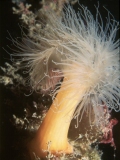 With fine, delicate tentacles they are unsuited to capturing large animals like fish. Instead they specialise in smaller prey such as small planktonic crustaceans. The anemone's columnar body is narrower just below the tentacles. A current will bend the stalk at this point and expose the tentacles broadside to the flow in the best position for feeding on suspended matter.
With fine, delicate tentacles they are unsuited to capturing large animals like fish. Instead they specialise in smaller prey such as small planktonic crustaceans. The anemone's columnar body is narrower just below the tentacles. A current will bend the stalk at this point and expose the tentacles broadside to the flow in the best position for feeding on suspended matter.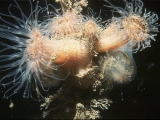 The Plumose anemone occurs from the Bay of Biscay (North of Spain) to Scandinavia in the northeast Atlantic, and on the west and east coasts of North America. It is unknown from the western basin of the Mediterranean but has been seen in the Adriatic, where it is believed to have been introduced. It has also been seen in Table Bay Harbour in South Africa where it was probably introduced from Europe.
The Plumose anemone occurs from the Bay of Biscay (North of Spain) to Scandinavia in the northeast Atlantic, and on the west and east coasts of North America. It is unknown from the western basin of the Mediterranean but has been seen in the Adriatic, where it is believed to have been introduced. It has also been seen in Table Bay Harbour in South Africa where it was probably introduced from Europe.

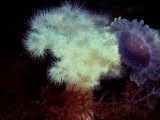
Further Reading:
Great British Marine Animals, by Paul Naylor
Ask Nature
What do you think of this news item? Join a discussion.
Labels: environment, Europe, marine biology, SCUBA diving, SCUBA News, SCUBA Travel, UK
Tuesday, July 21, 2009
Fish surveys could be inaccurate
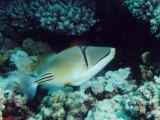 Fish surveys are often conducted by SCUBA divers or snorkellers. A study in the journal Environmental monitoring and assessment has found that these surveys may be inherently inaccurate as snorkellers frighten away the fish they are supposed to be counting.
Fish surveys are often conducted by SCUBA divers or snorkellers. A study in the journal Environmental monitoring and assessment has found that these surveys may be inherently inaccurate as snorkellers frighten away the fish they are supposed to be counting.Researchers from at the University of Victoria, Canada, used an underwater video camera to assess how fish abundance, family richness and community composition were affected by snorkellers and divers on a coral reef in Thailand. They found that snorkellers significantly disturbed the fish they were supposed to be recording. The SCUBA divers didn't provoke the same disturbance. However, only 6 divers were involved in the study so the results are not conclusive.
The researchers suggest that the use of a stationary video camera may help cross-check data that is collected by divers and snorkellers to assess the true family composition and document the presence of rare and easily disturbed species.
Journal Reference:
Environ Monit Assess. 2009 Apr 8
What do you think of this news item? Join a discussion.
Labels: environment, research, SCUBA diving, SCUBA News
Wednesday, July 15, 2009
Creature of the Month: Dragonet, Callionymus lyra

One hundred and eighty-six species of the "Little Dragon" fish live from Iceland in the North to the Indo-Pacific oceans in the South. You will find the species we are concentrating on today, Callionymus lyra, from Norway to Senegal: in the Eastern Atlantic and the North, Irish, Mediterranean, Black, Baltic, Aegean and other Seas.
The adult male C. lyra is colourfully patterned in orange and blue. The females are smaller and a mottled brown. They have an interesting courtship ritual. The male performs an elaborate display, darting around the female, spreading his brightly coloured fins and pulling faces! If the female is impressed the pair then swim side-by-side, almost vertically up to the surface. There they release the eggs and sperm into the water, spawning at dusk. Dragonet males are thought to mate only once in a lifetime.
Dragonets spend most of their lives on sandy or rocky bottoms. They live from the shallows down to 100 m. They are sometimes confused with gobies but have a much broader triangular, head and a long dorsal ray on their backs. If you see slender fish meeting this description darting away from you on the bottom it is probably a dragonet.
Further Reading:
Great British Marine Animals, by Paul Naylor
Labels: fish, marine biology, SCUBA diving, SCUBA News, SCUBA Travel, UK
Thursday, July 02, 2009
Belize barrier reef in Danger
The reef was added as a world heritage site in 1996 as the largest barrier reef in the northern hemisphere, with offshore atolls, several hundred sand cays, mangrove forests, coastal lagoons and estuaries.
The main problem with Belize Barrier Reef Reserve System concerns mangrove cutting and excessive development. The reef is also the country’s top tourist destination.
While requesting stricter control of development on the site, the World Heritage Committee also requested that the moratorium on mangrove cutting on the site which expired in 2008 be reinstated.
Further Reading:
List of World Heritage in Danger
What do you think of this news item? Join a discussion.
Labels: Belize, coral reef, SCUBA diving, SCUBA News, SCUBA Travel
Wednesday, June 03, 2009
Snorkeller killed by shark at St Johns, Egypt
The woman's leg showed visible bite marks, and medics said she probably bled to death before being lifted to the surface.
The shark was an oceanic white tip. Although inexperienced divers sometimes confuse it with the white tip reef shark, the oceanic shark is much bigger, stockier and often accompanied by pilot fish. Whereas the reef shark is no threat to divers, the oceanic white tip is one to be wary of and treated with respect. It is almost fearless and credited with many open-ocean attacks on people after air or sea disasters.
Saint John's is in the Southern Egyptian Red Sea. It is a popular destination for divers, a place where you often see large pelagic species. If you should encounter a oceanic white tip it is advisable to stay close to the reef and not to make any sudden movements.
What do you think of this news item? Join a discussion.
Labels: Red Sea, SCUBA diving, SCUBA News, SCUBA Travel, sharks
Monday, April 20, 2009
SCUBA Travel release last quarter's bestseller list
SCUBA Travel have just released their list of best selling diving books and DVDs of the last quarter. Yet again the Dive Atlas of the World keeps its top spot. The previous quarter's position is shown in brackets.
- Dive Atlas of the World: An Illustrated Reference to the Best Sites by Jack Jackson
300 pages detailing some of the world's best dive sites. (1) - Fifty Places to Dive Before You Die: Diving Experts Share the World's Greatest Destinations by Chris Santella
The fifth in Santella's bestselling "Fifty Places" series. (2)
- Dive in Style
by Tim Simond
Luxury diving around the world.(4) - Dive Red Sea: The Ultimate Guide by Simon Rogerson and John McIntyre
Covers popular Red Sea diving areas: mostly Egypt.(--) - Coral Reef Guide Red Sea (Coral Reef) by Ewald Lieske, Robert Myers
Covering jellyfish, corals, nudibranchs, starfish, sea urchins, fishes and turtles of the Red Sea. (3) - Coral Reef Fishes: Indo-Pacific and Caribbean by Ewald Lieske, Robert Myers
A compact, guide to over 2000 species of fish you might see whilst diving on coral reefs. (8) - Dive: The Ultimate Guide To 60 Of The Worlds Top Dive Locations by Monty Halls
Describes 60 of the world's best diving areas, and highlights specific dives not to be missed whilst you are there. (6) - Diver Down: Real-World SCUBA Accidents and How to Avoid Them by Michael R. Ange
Reveals how scuba diving accidents leading to severe injury or death usually result from a chain of events that can and should be prevented before a tragedy occurs. (7) - Red Sea Reef Guide by Helmut Debelius
Guide to marine life of the Red Sea (10) - Thailand (Lonely Planet Diving & Snorkeling Guides) by Tim Rock
Dive sites of Thailand. Includes city guide to Bangkok. (5)
What do you think of this news item? Join a discussion.
Labels: books, SCUBA diving
Thursday, March 26, 2009
Underwater photography competition: enter now
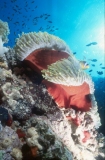 2009 is the 31st year of the International Festival of Underwater Photography, Films and Children's Artwork.
2009 is the 31st year of the International Festival of Underwater Photography, Films and Children's Artwork. The festival is open to both amateurs and professionals. You may enter by uploading photographs at http://www.paftachov.cz/en/www/. The deadline for accepting the works April 22nd 2009. The photographic categories include: wide-angle image without a diver; wide-angle image with a diver; macro image and water animal image.
The festival started in 1979. In the beginning it was a modest 16mm and 8 mm films competition, later upgraded with photographs.
As the time went by, categories expanded with slides, videos, and children's art works being added.
At first all competition works were assessed only by the audience. Then in 1994, professional juries were introduced.
In addition to local authors, participants in the come from many countries including Australia, Belgium, Egypt, Finland, France, Italy, Canada, Yugoslavia, Tunisia, Turkey, Ukraine, USA and Great Britain.
The festival is now an international event organised under the auspices of CMAS, the World Underwater Federation which is one of the oldest dive organisations in the world.
The originally one-day event has become a four-day event with a lot of space for discussions, friendships, offering divers plenty of experiences and issues to be assessed. Anyone can join this festival, which is aiming to present results of diver's works in many forms, the artistic in particular.
The festival takes place in Tachov, Czech Republic, from 21st to 24th May 2009.
Further reading:
http://www.paftachov.cz/en/www/
--
What do you think of this news item? Join a discussion.
Labels: photography, SCUBA diving, SCUBA News, SCUBA Travel
Tuesday, March 17, 2009
97% of Divers disturb seabed: Males worst offenders
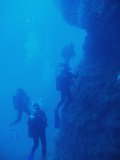 Most SCUBA divers disturb the seabed, Spanish researchers say. A study published in the ICES Journal of Marine Science found that nearly 97% of divers in marine protected areas (MPAs) made contact with the bottom. Inexperienced, male divers carrying a camera or torch were the worst offenders.
Most SCUBA divers disturb the seabed, Spanish researchers say. A study published in the ICES Journal of Marine Science found that nearly 97% of divers in marine protected areas (MPAs) made contact with the bottom. Inexperienced, male divers carrying a camera or torch were the worst offenders.Creating a marine protected area tends to increase diving in that vicinity. Scientists from the University of Alicante studied the behaviour of divers in marine protected areas, the effects of diving on the natural environment and the characteristics that influence diver behaviour. They found that impacts caused by recreational scuba activity vary widely among different divers.
The scientists followed a total of 181 recreational divers in Mediterranean MPAs, recording the contacts they made with the seabed and the effects produced. They also made notes on the features of the dive. Their observations revealed that 175 of the divers observed (96.7%) made at least one contact with the seabed. Flapping was the most frequent type of contact, and the main damage by this action was to raise sediment.
Contact with the seabed was greater for males than for females, inexperienced divers than for experienced divers, camera or dive light users than for non-users, and divers unaccompanied by a dive leader or who had not been briefed about avoiding seabed contact before undertaking a dive than for accompanied or briefed divers.
The research team hopes that a greater understanding of the causes of harmful behaviour may be useful for stricter management, reducing diving damage and assuring the sustainability of diving in marine protected areas.
Journal Reference:
Luna, B., Valle Pérez, C., and Sánchez-Lizaso, J. L. 2009. Benthic impacts of recreational divers in a Mediterranean Marine Protected Area. – ICES Journal of Marine Science, 66: 000–000.
--
What do you think of this news item? Join a discussion.
Labels: Mediterranean, research, SCUBA diving, SCUBA News, SCUBA Travel
Wednesday, March 11, 2009
Survey Reveals Top 10 Dive Sites in Europe
- The Zenobia, Cyprus
The pristine wreck of a huge ferry. Lying on its port side, the wreck starts at about 15 m and descends to 42 m. Fabulous dive. Possibly the best shipwreck dive in the world in recreational depths. 20 m plus visibility and some great swim-throughs. Needs several dives to see anything like all of it.
- Blue Hole, Gozo
A beautiful sharp drop off into the blue hole with what seems like limitless visibility and literally feels like you are on the very edge of the world. A most extraordinary dive.
- Cirkewwa, Malta
Features the wreck of the Rozi MV as well as stunning underwater topography. Visibility is very good and there iss ea life in abundance: barracuda, morays, octopus, cuttlefish and even dolphins.
- Booroo, Isle of Man
The Burroo, with its extremely diverse and plentiful marine life offers a truly magnificent dive. In fact, in areas exposed to the fast flowing current, it is something of a challenge to find a single square centimetre of bare bedrock, so abundant is the life here.
- Blockship Tabarka, Scapa Flow, Scotland
This shallow 18 m dive is a real beauty. One of the block ships scuttled to prevent submarine attack during WW2. Covered in life, a beautiful place. Worth the trip and the one of surprises of Scapa.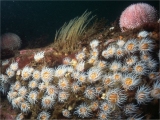
- Diamond Rocks, Kilkee, Ireland
Claimed to by on a par with the famous Yongala. It is a cold water dive off Ireland's west coast. The bay is fairly sheltered and is teaming with life. The terrain is full of rocks and gullies and the water is really clear.
- Eddystone Reef, England
12 miles off Plymouth, England. The reef is from 8 to 60 m. Encrusted with jewel anemones and with the remains of ancient wrecks, including a large 17th century anchor. Stunning.
- Secca della Columbara, Italy
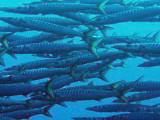 One of the best dives in the Mediterranean. It features a steep, beautifully-decorated, wall; large shoal of barracuda; grouper; giant amberjacks and a wreck. The wreck is a 74 m ship which was carrying slabs of marble. It sank in 2005 and rests at 20 m in two parts.
One of the best dives in the Mediterranean. It features a steep, beautifully-decorated, wall; large shoal of barracuda; grouper; giant amberjacks and a wreck. The wreck is a 74 m ship which was carrying slabs of marble. It sank in 2005 and rests at 20 m in two parts.
- Fanore, Ireland
Shore dive in crystal clear Atlantic water with abundant fish.
- Chios island, Greece
Small undersea caves and paths between impressive rocks, colourful reefs and vertical walls.
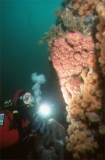
What do you think of this news item? Join a discussion.
Labels: Europe, Greece, Ireland, Italy, Malta and Gozo, Mediterranean, SCUBA diving, SCUBA Travel, UK
Friday, November 21, 2008
Computers decide when to stop searches at sea
The Search and Rescue Survival Model has been designed to take the pressure off rescuers making difficult decisions about when a search and rescue mission should be stopped.
“Using this new computer model will take pressure off humans making very emotional and sensitive decisions about when to end a search,” said Professor Mike Tipton, human and applied physiologist, from the University of Portsmouth.
“When the model predicts that a victim can no longer survive, the search and rescue team can stop or redeploy the search.
“It will ensure that Coast Guard personnel are not exposed to the high risks associated with search and rescue operations any longer than necessary and will also help to save time and resources,” he said.
The US Coast Guard currently uses a software system known as SAROPS (Search and Rescue Optimal Planning System) to calculate how far a person will have drifted and how large the search area should be.
Data such as wind speed, sea state and water temperature is entered into SAROPS along with information about the victim’s sex, height, weight and what they were wearing to determine exactly how the search should be conducted.
“Calculating survival time will add another layer to SAROPS; it will be able to predict not only where a search should be conducted but when it should be stopped,” said Professor Tipton.
“The University of Portsmouth has been able to tap into and analyze data held by the Institute of Naval Medicine and the Royal National Lifeboats Institution, both critical to the development of this survival model. To our knowledge no other similar repository of this information exists - even in the US.
“The development of this technology is very exciting. It will be trialled in American waters in late 2009 and once thoroughly tested, the aim is to roll it out to the whole of the US,” he said.
Labels: America, research, SCUBA diving, USA
Wednesday, May 07, 2008
Dominica’s Dive Fest celebrates 15 years
 Dominica’s Dive Fest, the Caribbean’s longest running scuba diving festival, encourages visitors to discover the beautiful landscapes and colourful marine life within the island’s waters. Would-be divers and snorkellers as young as eight can participate in pool- or ocean-based introductory sessions to teach them the basics, with some trial sessions even offered completely free of charge.
Dominica’s Dive Fest, the Caribbean’s longest running scuba diving festival, encourages visitors to discover the beautiful landscapes and colourful marine life within the island’s waters. Would-be divers and snorkellers as young as eight can participate in pool- or ocean-based introductory sessions to teach them the basics, with some trial sessions even offered completely free of charge. The annual event takes place in Dominica from 11th – 20th July 2008. To mark this special 15th anniversary year, many local dive centres are offering group travel packages whereby one diver goes free with every seven that book.
“Dive Fest was established to showcase the incredible marine environment of Dominica to both visitors and residents and is now one of the island’s staple events” comments Steve Bornn, director of tourism at the Discover Dominica Authority.
More information on the Dive Fest can be found at can be found at www.dominicawatersports.com. For more on diving Dominica see SCUBA Travel: Dominica
Labels: Caribbean, dive destination, Dominica, SCUBA diving, SCUBA Travel
Tuesday, October 16, 2007
Scientists develop artificial coral reef in Red Sea
Take a dive off the coast of Eilat these days and you're liable to find yourself swimming around a huge yellow concrete and wire construction that stretches four yards up from the seabed, is four yards wide, and is full of holes.
The reef is a unique new approach to conservation in the Red Sea and part of a joint co-operative project between Israel and Jordan.
Dr. Nadav Shashar, the supervisor of the research project, and a marine biologist at the National Center for Mariculture, says "Because of the increase in the number of visitors, the coral reefs are unable to overcome the damage caused and are beginning to die out.
Part of the problem is novice divers. "They kick up the sand, or damage the corals by accident. Multiple that by 100,000 people and that's considerable damage," says Shashar. "These people don't mean to harm the reefs, but they just don't know how to dive properly."
The developers hope that the artificial reef will create a new attraction for these divers, steering them away from the natural reefs, reducing the pressure there and enabling them to recover from some of the damage inflicted on them over the last few years.
At the same time, the Tamar reef which is located near Coral Beach also provides the researchers with a unique underwater laboratory, enabling them to observe and unravel the development and growth of this unique and complex ecosystem.
Further reading: Israel Ministry of Foreign Affairs
What do you think of this news item? Join a discussion.
Labels: coral reef, dive destination, Red Sea, SCUBA diving, SCUBA Travel